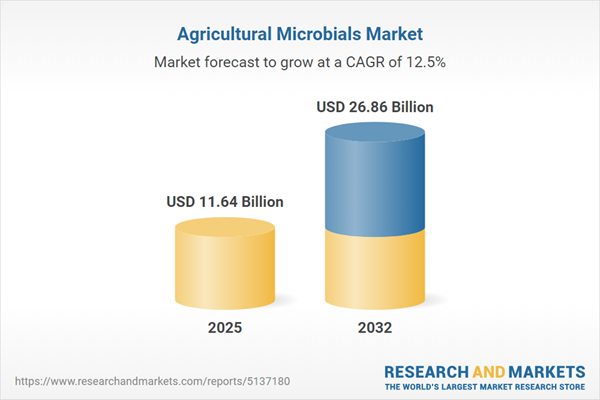Speak directly to the analyst to clarify any post sales queries you may have.
Senior executives are prioritizing agricultural microbials as crucial drivers for sustainability, compliance, and agile supply chain management. With biological solutions moving toward the core of enterprise strategy, leaders are leveraging these innovations to futureproof operations in a dynamic agri-food sector.
Agricultural Microbials Market Snapshot
The global agricultural microbials market is experiencing robust expansion. In 2024, the market reached a valuation of USD 10.43 billion, with a stable 12.54% CAGR reflecting consistent sector advancement. Growth is propelled by biotechnology innovations, strategic shifts in agribusiness priorities, and an increased focus on resilient food systems. Regulation is adapting to enable smoother integration of biological products into mainstream crop management. Enterprises are prioritizing food safety, sustainable practices, and adaptable supply chains to boost marketplace resilience and meet evolving stakeholder demands.
Scope & Segmentation of the Agricultural Microbials Market
- Product Categories: Biofertilizers enhance nutrient uptake and soil vitality, supporting regenerative models; biopesticides safeguard yields with targeted protection strategies; biostimulants help crops handle climate extremes while reinforcing yield reliability and sustainability.
- Microorganism Types: Bacteria, fungi, protozoa, and viruses are selected and tailored to crop-specific and regional requirements, ensuring both yield improvements and adherence to local compliance and sustainability mandates.
- Formulations: Capsules, tablets, powders, and liquids are formulated for varied scale and flexible integration with enterprise workflows, minimizing operational disruptions during application.
- Crop Segments: Solutions are designed for cereals, oilseeds, grains, pulses, fruits, and vegetables, providing organizations with tools to optimize risk management, serve commodity and specialty markets, and align with shifting procurement requirements.
- Packaging Types: Blisters, bottles, cans, and sachets safeguard active ingredients through the supply chain, ensuring product performance from origination to final user while reducing dependency on single-location storage logistics.
- Application Methods: Foliar spraying, seed treatments, and soil drenching allow fast on-farm rollouts at various operational scales, simplifying adoption and reducing integration barriers across business units.
- Distribution Channels: Ag-retailers, specialty distributors, B2B digital platforms, and e-commerce expand organizational access, facilitating strategic sourcing and strengthening procurement resilience.
- Regional Markets: Growth is prominent in China, India, Japan, Australia, and leading European countries, with local production patterns, regulatory landscapes, and changing consumer priorities shaping competitive dynamics and adoption rates.
- Company Coverage: Key market players including BASF SE, Bayer AG, AgBiome, and Bioceres Crop Solutions are advancing collaborative models to align innovation with regional regulations and emerging enterprise needs.
Agricultural Microbials: Key Takeaways for Senior Decision-Makers
- Ongoing progress in genomic and fermentation technologies is accelerating the development pipeline for new microbial products, allowing organizations to address changing crop health and environmental stressors swiftly.
- Regulatory changes are simplifying the deployment of biologicals, lowering adoption barriers and enabling rapid scaling or diversification within operational footprints.
- Synergistic partnerships between agtech startups and established sector leaders are expanding the breadth of crop applications while integrating next-generation biotechnologies into practical use.
- Digital farm management systems are increasingly providing real-time analytics for resource allocation, empowering leadership teams with data-driven decision support throughout the production cycle.
- Organizations are better equipped to enter specialty crop segments and maintain compliance with dynamic export regulations, ensuring business continuity and alignment with diverse buyer requirements.
Tariff Impact: Navigating U.S. Policy Shifts in the Microbial Sector
Recent U.S. tariff changes have introduced new complexities for the agricultural microbials sector. Enterprises are responding with diversified sourcing strategies, enhancing regional and domestic production, and adjusting procurement processes. These actions, combined with strengthened logistics, are reinforcing operational continuity despite shifts in policy and market landscape.
Methodology & Data Sources
This report draws on executive interviews, patent analysis, regulatory research, and scenario-based forecasting. Employing these robust methods ensures actionable, leadership-focused insights relevant to strategic business planning and investment decisions.
Why This Report Matters
- Supports management teams in optimizing investments and building effective partnerships as the agricultural microbials sector and regulatory context evolve.
- Offers practical intelligence for digital supply chain integration and agile adaptation to new policies and procurement conditions.
- Delivers valuable benchmarking and competitive perspectives, highlighting new regional and segment opportunities for growth.
Conclusion
This analysis provides senior leaders with clear, strategic direction for adopting biological innovation to strengthen resilience, enhance adaptability, and ensure sustainable differentiation in the evolving agricultural landscape.
Additional Product Information:
- Purchase of this report includes 1 year online access with quarterly updates.
- This report can be updated on request. Please contact our Customer Experience team using the Ask a Question widget on our website.
Table of Contents
3. Executive Summary
4. Market Overview
7. Cumulative Impact of Artificial Intelligence 2025
List of Figures
Companies Mentioned
The companies profiled in this Agricultural Microbials market report include:- BASF SE
- Bayer AG
- AgBiome, Inc.
- Bioceres Crop Solutions Corp.
- BioConsortia, Inc
- Bionema Ltd.
- Certis USA LLC
- Concentric Ag
- Croda International PLC
- Evogene Ltd.
- FMC Corporation
- Heliae Development, LLC
- Indigo Agriculture Inc
- Kemin Industries, Inc.
- Kimitec Group
- Koppert Biological Systems
- Novozymes A/S
- Nufarm Limited
- Pivot Bio, Inc.
- Seipasa S.A.
- T.Stanes & Company Ltd.
Table Information
| Report Attribute | Details |
|---|---|
| No. of Pages | 186 |
| Published | November 2025 |
| Forecast Period | 2025 - 2032 |
| Estimated Market Value ( USD | $ 11.64 Billion |
| Forecasted Market Value ( USD | $ 26.86 Billion |
| Compound Annual Growth Rate | 12.5% |
| Regions Covered | Global |
| No. of Companies Mentioned | 22 |









